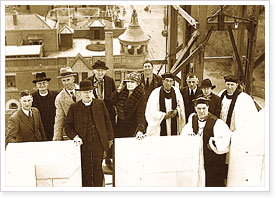The History of St David's begins long before the construction of our present building
Scroll down to learn about some of the key dates in our history up to 1936...
Faith Journey brochure
1803
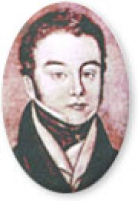 Lt John Bowen arrived in Van Diemen’s Land in September 1803. Ships Albion and Lady Nelson. First settlement at Risdon Cove on River Derwent.
Lt John Bowen arrived in Van Diemen’s Land in September 1803. Ships Albion and Lady Nelson. First settlement at Risdon Cove on River Derwent.
Lt Gov David Collins in ships Calcutta and Ocean attempted settlement in Port Phillip at Sorrento to command Bass Strait from the north side in October 1803.
1804
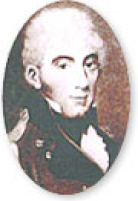 Lt Gov David Collins abandoned Port Phillip and sailed to the River Derwent in ships Lady Nelson and Ocean and took command of the settlement which was relocated to Sullivan’s Cove founding Hobart Town in February 1804.
Lt Gov David Collins abandoned Port Phillip and sailed to the River Derwent in ships Lady Nelson and Ocean and took command of the settlement which was relocated to Sullivan’s Cove founding Hobart Town in February 1804.
The Reverend Robert Knopwood was the expedition’s chaplain and was long the sole chaplain of Van Diemen’s Land. 
Colonel William Paterson sent from New South Wales in the Lady Nelson to settle at York Town on the west arm of the Tamar River to command Bass Strait from the south side arrived in early November 1804.
1810
Lt Gov David Collins died 24 March 1810 and was buried at Hobart Cemetery (now St David’s Park).
A church constructed of wood was erected over David Collins’ grave as a temporary place for public worship. The church was never consecrated, it is unsure if it was used, but in 1812 it was blown away in a tempest.

1812-17
From 30 June 1812 the seat of government of the whole of Van Diemen’s Land was located in Hobart Town, still responsible to New South Wales.
In February 1813 Lt Gov Thomas Davey gained approval from Governor Lachlan Macquarie of New South Wales of plans for erection of St David’s Church. Other projects namely a Military Barracks and a Colonial Hospital took precedence.
On 19 February 1817 the foundation stone of the St David’s Church was laid on the corner of Murray and Macquarie Streets by Thomas Davey to perpetuate the memory of the late David Collins.
1823
 The Church was a long time in building and on 9 January 1823 St David’s Church was consecrated by the Reverend Samuel Marsden, Senior Chaplain of New South Wales, who visited Hobart Town under Commission of the Archbishop of Canterbury.
The Church was a long time in building and on 9 January 1823 St David’s Church was consecrated by the Reverend Samuel Marsden, Senior Chaplain of New South Wales, who visited Hobart Town under Commission of the Archbishop of Canterbury.
The same year the Reverend William Bedford succeeded Robert Knopwood as chaplain.
1835-36
 On 7 January 1835 the steeple of the Church was declared unsafe, and taken down.
On 7 January 1835 the steeple of the Church was declared unsafe, and taken down.
On 18 March 1835 a tower known as the Pepper Pot was erected in its place.
In 1836 the first Archdeacon of Van Diemen’s Land, the Reverend William Hutchins, was appointed and held office until his death in 1841 (The Hutchins School founded in 1846 was named in his memory).
1842
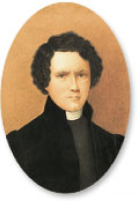 By Letters Patent under the Great Seal of Queen Victoria on 21 August 1842 the Reverend Francis Russell Nixon was appointed first Bishop of Tasmania.
By Letters Patent under the Great Seal of Queen Victoria on 21 August 1842 the Reverend Francis Russell Nixon was appointed first Bishop of Tasmania.
With the Founding of the See, Hobart Town was declared a City and St David’s Church became St David’s Cathedral.
Bishop Nixon was enthroned in the old St David’s on 27 July 1843 by the Senior Chaplain, Dr William Bedford.
1862
 On 17 January 1862 St David’s Cathedral and land on the corner of Murray and Macquarie Streets, Hobart was granted by the Crown to the Trustees of the Diocese of Tasmania (Thomas Reiby, Edward Samuel Pickard Bedford and William Stanley Sharland).
On 17 January 1862 St David’s Cathedral and land on the corner of Murray and Macquarie Streets, Hobart was granted by the Crown to the Trustees of the Diocese of Tasmania (Thomas Reiby, Edward Samuel Pickard Bedford and William Stanley Sharland).
The design architect for the new St David’s Cathedral was George Frederick Bodley. Bodley was a leading exponent of Gothic Revival in ecclesiastical architecture in England during the 19th century, however he never visited the Hobart site.
1868
On 8 January 1868 the foundation stone of the present St David’s Cathedral (the second St David’s Church) was laid by HRH Prince Alfred the Duke of Edinburgh in the presence of Governor Thomas Gore Browne, Premier Sir Richard Dry and a large concourse of clergy and laity.
The ceremony was conducted by the second Bishop of Tasmania, the Right Reverend Charles Henry Bromby. The supervising architect for the building was famous Tasmanian architect Henry Hunter. The builder for the project was James Gregory.
1872-74
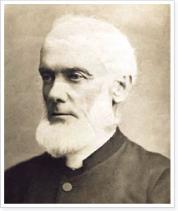 In 1872 the Reverend Frederick Holdship Cox was appointed first Dean of Hobart. On 3 February 1874 the nave of the new St David’s Cathedral was consecrated by Bishop Bromby.
In 1872 the Reverend Frederick Holdship Cox was appointed first Dean of Hobart. On 3 February 1874 the nave of the new St David’s Cathedral was consecrated by Bishop Bromby.
A procession took place from the old St David’s which was still standing to the west door of the new Cathedral. In September 1874 the old St David’s Cathedral was pulled down.
1891-94
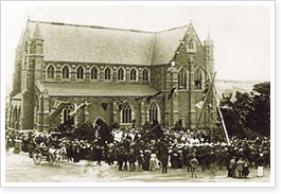
On 12 January 1892 the foundation stone of the Cathedral tower was laid by His Grace the Primate of Australia with Bishop Montgomery conducting the service in the year of the 50th Anniversary of the Founding of the See and the 250th of the discovery of the Island by Abel Tasman.
On 18 January 1894 the Cathedral Chancel and the Nixon Chapel were consecrated by Bishop Montgomery. This coincided with a Church Congress of Australia and New Zealand.
1908
 In August 1908 work on reconstruction of the Chancel began as it was in danger of collapse.
In August 1908 work on reconstruction of the Chancel began as it was in danger of collapse.
The work of reconstruction was completed in April 1909.
1929-31
Work did not commence on erection of the tower until 1929 when an anonymous legacy of £7,000 plus other gifts started the Tower and Cloisters Fund. Work progressed under supervision of architect Alan Walker with contractor H W Pease.
On 1 March 1931 (St David’s Day) the cloisters and the base of the tower were opened and consecrated by the Bishop of Tasmania the Right Reverend Robert Snowdon Hay DD.
1936
Completion of the Bell Tower 28 October 1936.
Final completion of the plans originally drawn by George Frederick Bodley, 68 years after commencement.
